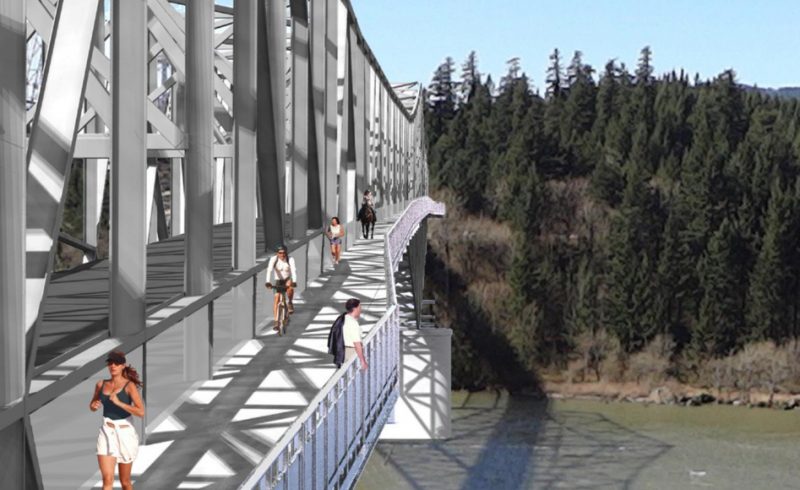
(Graphics: Port of Cascade Locks)
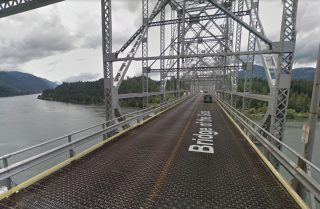
A biking and walking path on the Bridge of the Gods took a big step forward last month.
In March, the Port of Cascade Locks and the Pacific Coast Trail Association (in cooperation with the United States Forest Service, Washington Department of Transportation, Friends of the Columbia Gorge, and City of Stevenson, WA) turned in a proposal (PDF) to the Federal Highway Administration requesting $934,000 for a planning study that would lead to the construction of the project.
The bridge is a major part of tourism in the area and it services as a key link in the transportation network. It’s the access point for the popular Pacific Crest Trail, West End Transit bus service, two Scenic Byways, and other significant trails. Unfortunately, the bridge is narrow at just 22 feet-wide, has no shoulders or sidewalks, and is quite unnerving to use — even in a car!
Port of Cascade Locks Manager of Bridge Operations Ryan Vollans told us today via email that, “The Port feels strongly that this project greatly enhances pedestrian and bicycle safety at the Bridge and this improvement has been necessary for some time.”
Here’s an excerpt from the proposal:
The bridge is unsuitable for safe pedestrian traffic with a narrow 22-foot roadway lacking even minimal shoulders. It is a perilous situation for pedestrians to safely access then cross this narrow bridge, 1/3 mile long, with nothing to separate them from traffic, and the water visible under their feet 140 feet below the steel grate. Safety risks increase when tractor-trailers must swerve to go around pedestrians into oncoming traffic, and other motorists are sometimes paying more attention to the scenic views than to the road.
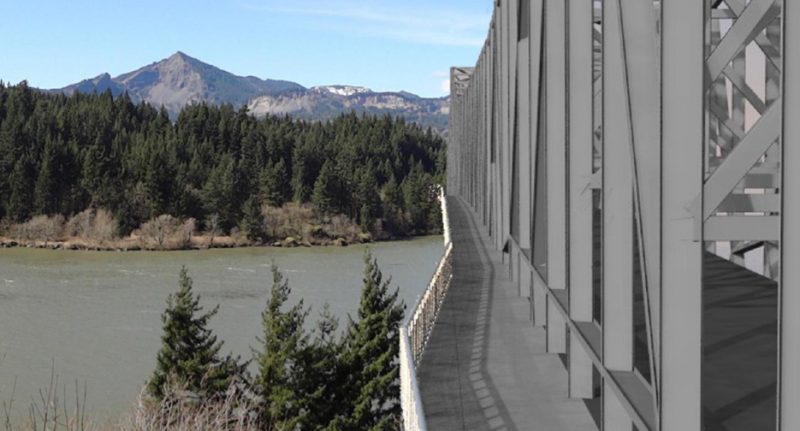
Advertisement
Despite that, the number of people who walk across the bride has risen significantly in the past four years nearly doubling between 2014 and 2017 (from 4,700 to 7,800 respectively).
In addition to a cantilevered path, the project — estimated to cost between $15 and $25 million — would include a seismic retrofit, new paths connecting nearby trails to the bridge, and safety upgrades to cross adjacent highways (see image below).
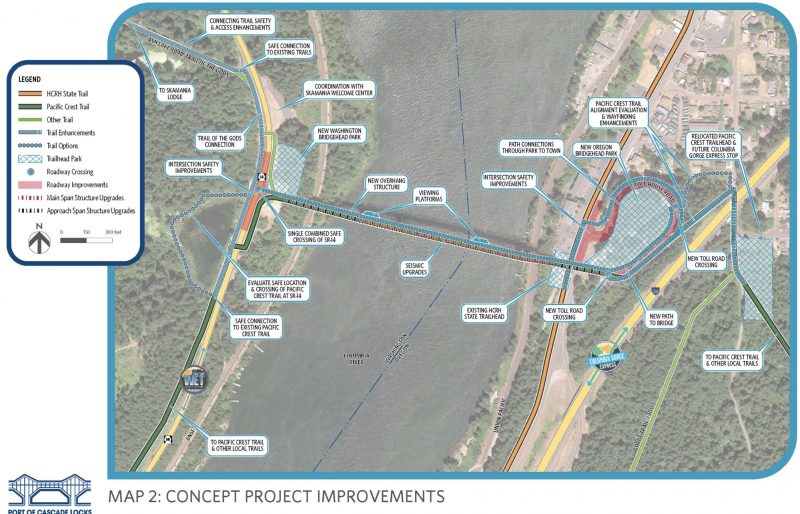
A story in today’s Oregonian reported that the project has major backing by from Oregon and Washington’s congressional delegation. A 2017 bill that would have directed the Oregon Department of Transportation to begin the project, didn’t make it out of committee.
The Port and its partners seek funding through the Federal Lands Access Program. If chosen, it would allow the Port to select a final bridge design, study environmental impacts, refine cost estimates, and get the project ready for future funding. The proposal is being evaluated now and Vollans says they expect a final decision to be made in August or September of this year.
Vollans says if the current schedule holds, the new path and other upgrades would be completed by 2024.
With a big push for carfree travel in the Columbia River Gorge, this project can’t happen soon enough. Stay tuned for opportunites to weigh in with your comments.
— Jonathan Maus: (503) 706-8804, @jonathan_maus on Twitter and jonathan@bikeportland.org
Never miss a story. Sign-up for the daily BP Headlines email.
BikePortland needs your support.



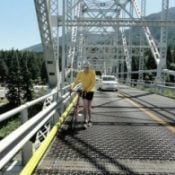


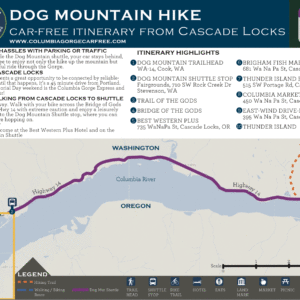
Thanks for reading.
BikePortland has served this community with independent community journalism since 2005. We rely on subscriptions from readers like you to survive. Your financial support is vital in keeping this valuable resource alive and well.
Please subscribe today to strengthen and expand our work.
This is wonderful news!
This would be great, opening up opportunities to get to places like Stevenson and Carson from the Oregon side, for those riding the Gorge Express – and vice-versa, for those taking the bus (can’t remember the name) on the Washington side.
Of course a similar path on the Hood River bridge would be an even greater need IMO, although at least there’s allegedly taxi service across that bridge.
There are preliminary plans to replace the Hood River bridge. Plans for a new bridge would include pedestrian and bike access. It’s got a long way to go to figure out funding for it, but it is something they’re working on.
Ricky Bobby at Hood River Taxi has a minivan you can fit a bike in. Locals typically pick up hitchhikers waiting to cross the bridge, and there are plenty of locals with vans and pickups that would likely be willing to take a bike.
Gee, I guess the gods drive pickup trucks and never walk or bike to have given us a bridge like this.
In modern America, that does seem to be the prevailing perspective. Jesus drove a lifted F250 with engine modifications.
I doubt there was much demand for walking and biking here in 1953.
The bridge was built in 1926.
Last major retrofit was in 1953. By the way, departing at 3:30 PM on Tu, We, Th from Gateway Max station you can get here via Columbia Area Transit (or continue on to Hood River and The Dalles).
’tis a most-excellent suggestion. My design suggestion is to get the pedestrian decking low enough that we can walk and ride with their heads below car-deck height. Those concept images put the pedestrian’s ears at precisely tire/deck height; it would be painfully loud.
‘course, it couldn’t actually be built without a debris barrier between the car and pedestrian decks. I suppose that could also be designed as a sonic barrier.
Look again. The vehicle and bike decks are on the same plane vertically.
Gotta love how Washington and Oregon can suddenly cooperate on a bridge project to serve 8,000 people a year, but when it comes to the CRC that would actually serve a significant amount of people in the largest population center in OR, they can’t come to an agreement and instead throw thousands of dollars away on nothing.
Thousands? Ha! Try hundred million+!!!
This project sounds pretty neat to me btw.
A few corrections:
The existing CRC already serves those people, albeit not to the satisfaction of everyone. You can’t argue that the existing bridges don’t work for cars. In this case, this bridge only works for cars. It doesn’t really work for trucks, pedestrians or cyclists.
ODOT/WSDOT spent nearly $200 MILLION dollars studying and designing an incredibly flawed replacement solution for the CRC.
Yep, I meant millions. Just seems funny to me that a bridge that would serve far more people never made it off the ground while a bridge for 8,000 people per year is getting cross-state cooperation and funding. MAX to Vancouver would have likely exceeded 8,000 riders per day.
You can’t get MAX into Vancouver for less than $1 billion, unless the line literally just terminates downtown. And besides, Clark County folks don’t want the “crime train”.
I’m content to let them sit in traffic until they come around to accepting the need for mass transit. An expanded railroad bridge could get commuter trains from west Vancouver to downtown Portland in 12 minutes. Even with a new I-5 bridge, vehicle traffic will still come to a standstill in north Portland.
8,000 per year is the current volume, the number of people who dare walk across a scary bridge in the middle of a traffic lane.
It’s pretty safe to presume that a dedicated path would serve several times the current volume.
Eleven foot travel lanes work just fine for trucks. I’ve driven trucks with doubles over bridges that have only nine foot travel lanes and oncoming trucks without distress. In spite of ODOT’s contention that trucks need boatloads of room, it just isn’t so.
Eleven foot lanes also work fine on a bike, but one does have to get off the railing and take the lane. It’s not perfect, but it works. Now for pedestrians, we’ve got an entirely different situation. Great that the bridge is adding pedestrian amenities; all bridges should have them, imo.
I think you’re mistaken when you say this bridge serves 8,000 people per year. Per the article, this bridge currently serves 8,000 PEDESTRIANS per year. Which is sort of amazing since there’s no sidewalks or shoulders on this bridge.
I’m sure the vast majority are PCT thru-hikers. I wouldn’t be surprised if crossings go up 200 or 300 percent if this pathway is built.
They issued 4,000 permit for through hikers last year with 700 or so completing it. With California being the starting point and the longest section, many go home before reaching the BOTG.
There are many section hikers on the PCT however, which people don’t get a permit for since it isn’t needed. A lot of folks can’t take five months off, but can take a month off to hike Washington or Oregon, which the bridge makes a nice starting/ending point.
Yep, I wasn’t answering as to section hikers. I’ve done sections of it as well. The above fellow said “through hikers.”
You’re splitting hairs here.
Its likely due to two “3rd Rail” reasons: no expanded motor vehicle capacity (OR – Portland) and no light rail (WA – North Clark County)…
Nice horse!
Virtual bridge, virtual horse, virtual bike, virtual people.
What else do we need?
Virtual funding.
It is great to hear and update on this – given how challenging it can be to ride a bike on the squirrely decking…and the importance of active transportation tourism to the Gorge communities.
[Plus it is always good to see a project one worked to support technically move forward.]
my scariest moment on a bike was when i biked across that bridge. strong winds and see through metal grading do not mix for the most comfortable experience. hoping they add a high guard rail.
Let’s just state the obvious reason behind the need……it is the crossing of the Pacific Crest Trail from Washington to Oregon. That alone is reason to make it safe to walk across. I don’t mind biking in the current conditions (speed limit is 15mph) but if you’re a thru hiker doesn’t being able to safely walk across just make sense?
If carried out, this might open up opportunities to create a bike/ped loop, with the I-205 bridge path on one side and the BOTG on the other. And maybe talk of an I-5 bridge replacement could start once that loop is completed. It’s also worth noting that Oregon’s average gas price just went thru the $3/gallon barrier.
You excited to ride alongside semi’s on that stretch of 14? No thanks. Plenty of other good riding that doesn’t include that almost unchangeable factor.
I’m all in favor of this path, but not so I can do a loop with I-205. No way in hell would I ever ride that stretch of WA-14.
I’m with Doug on this. Not sure why anyone that didn’t live there would want to bother.
I have ridden out there just for the heck of it. The bridge is outdated and inadequate, but speeds are slow enough I don’t think of it as unsafe. Are we aware of any actual collisions (keeping in mind that collisions occur all the time on “ordinary” streets)?
The bridge and surrounding area could be a lot better from both walking and riding perspectives. But I’m not sure it’s worth building trails that people hordes of people drive to that provide a garden variety experience. There are plenty of other overrated (and better) destinations.
I don’t mind it as is since the speeds are low. Hey, isn’t this the bridge that Mojo Nixon used in an album sleeve?
Not to be confused with Moe Dixon, who lives in the gorge…
I’m missing something; why all the cyclist excitement about this? I’ve crossed the bridge, and it was zero stress. OK, maybe a little, because of the metal grate and view of the river below. People, at some point we have to think, is this the best way to spend $25 Million? The country has lots of priorities, and this ranks pretty low.
I think the wrong limb of the story was highlighted. Usage is pretty low considering the cost but they will also make it more seismic ready. But yes, I do wonder about people who talk about unsafe and fearful of the walk/ cycle situation as it stands.
I predict viewing the river from the bridge and throwing things in will become a not insignificant tourist attraction. Cascade Locks probably stands to make well over the construction cost just giving tourists something new to do.
Looks like it will be more pleasant to ride across, too. Never walked it, but I can imagine it’s no fun as is if there is auto traffic in both directions.
Zip line to Thunder Island.
I walked it when they closed it for a day, two years ago, and it was great. Just being able to relax and take photos off the side was wonderful. Granted, that closure was carfree, so completely calm and quiet, but even side paths would offer such a nice experience and vantage over the river. All those times I drove over it, I never appreciated the height and views from either side. I can imagine stopping there and walking it much more often, if they do this.